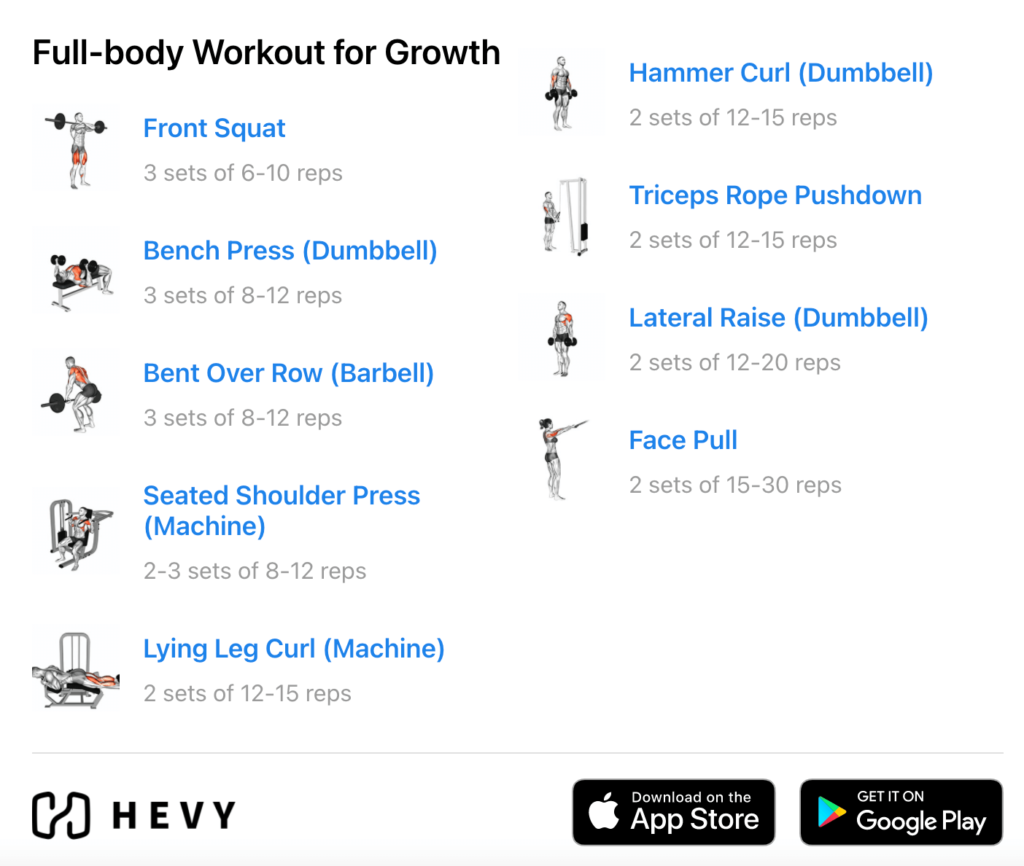Introduction to Full Body Workouts
Having a strong body is incredible. It allows us to contribute more, perform better in sports, and handle everyday tasks with ease. For instance, greater physical strength will enable us to be more competitive in contact sports and perform daily activities like carrying groceries more efficiently (1).
Having a strong body also improves our posture, reduces our risks of injuries, and allows us to maintain healthy bones (2).
Full body training is a fantastic way to build muscle and get stronger, regardless of your experience. Most notably, full-body training allows us to optimize our training frequency and give each muscle some attention with as few as two weekly workouts. This kind of training is excellent for everyone, especially those with limited time to train.
Because of the unique structure of these workouts, you can also have more time to recover between workouts and without worrying about training the same muscle group too frequently. For instance, if you want to train only twice per week, you can space out your workouts by a few days and always hit the gym fresh and recovered. To track your workout efficiently, try using the Hevy. It is great for logging workouts and keeping track of your progress.

Hevy – Workout Tracker
Create your own full-body workouts with Hevy, and track your progress









Hevy – Workout Tracker
Create your own full-body workouts with Hevy, and track your progress – for free.
Six Full Body Workouts for Strength and Muscle Mass
1. Whole-Body A/B Split
As we briefly discussed in the introduction, a great benefit of full-body workouts is you can train as little as two times per week and still cause a significant enough stimulus. With that in mind, doing the same training every time is not great because you’re constantly training your muscles in the same way, and things can get stale.
So, we’ve put together a whole-body A/B 2 day split that works perfectly, especially if you only have time for two workouts each week. For instance, you can do workout A on Monday and B on Thursday – easy-peasy.
As you’ll see in a moment, both workouts train your whole body, but they have some minor differences between them. It’s precisely these differences that make your training more engaging and allow you to vary the stress you impose on your muscles, joints, and connective tissues.


Whole-Body Workout A
- Front Squats – 3 sets of 8 to 10 reps
- Bench Press (Barbell) – 3 sets of 8 to 10 reps
- Barbell Rows – 3 sets of 8 to 12 reps
- Shoulder Press (Machine) – 2-3 sets of 8 to 15 reps
- Barbell Bicep Curls – 2-3 sets of 6 to 10 reps
- Hamstring Curls (Machine) – 2 sets of 10 to 15 reps
- Seated Calf Raises (Machine) – 2-4 sets of 8 to 20 reps
Whole-Body Workout B
- Hip Thrusts – 3 sets of 6 to 10 reps
- Incline Press (Dumbbells) – 3 sets of 8 to 12 reps
- Pull-Ups – 3 sets of 5 to 20 reps
- Standing Overhead Press (Dumbbell) – 2-3 sets of 8 to 12 reps
- Leg Press – 2-3 sets of 8 to 15 reps
- Rope Cable Tricep Extensions – 2-3 sets of 12 to 20 reps
- Standing Calf Raises (Machine) – 2-4 sets of 8 to 20 reps
2. Full Body Workout for Muscle Growth
Training for optimal strength and muscle growth shares many similarities. You have to work hard, pick the right exercises, do enough work, and recover well between individual sets and workouts. But, training for optimal growth primarily depends on doing enough work (sets and reps), training at a moderate intensity, and giving each muscle group enough attention (3, 4).
This workout is designed to cause superior hypertrophy but isn’t that well suited for folks who mostly care about getting as strong as possible. Let’s review:
- Front Squats – 3 sets of 6 to 10 reps
- Dumbbell Bench Press – 3 sets of 8 to 12 reps
- Bent-Over Barbell Row – 3 sets of 8 to 12 reps
- Overhead Shoulder Press (Machine) – 2-3 sets of 8 to 12 reps
- Lying Hamstring Curl (Machine) – 2 sets of 12 to 15 reps
- Dumbbell Hammer Curls – 2 sets of 12 to 15 reps
- Rope Cable Tricep Extensions – 2 sets of 12 to 15 reps
- Lateral Dumbbell Raises – 2 sets of 12 to 20 reps
- Rope Cable Face Pulls – 2 sets of 15 to 30 reps
3. Full Body Strength Program
Unlike the previous workout, the primary goal is to trim the fluff from your training and focus your efforts on building raw strength. Meaning, we’ll be dealing with fewer exercises here, primarily focusing on lifting heavier weights and resting longer between sets (5, 6).


Also, since research suggests that a higher training frequency is more beneficial for strength gains, we encourage you to do this workout two to three times per week (7). The more frequent exposure and getting to practice each lift will improve your neuromuscular capacity and get better at each exercise.
Plus, thanks to the decently high training volume, you should also expect to build a fair amount of muscle mass, contributing to your strength gains.
Let’s see what the workout is:
- Low-Bar Back Squats – 3-4 sets of 4 to 6 reps
- Barbell Bench Press – 3-4 sets of 4 to 6 reps
- Conventional or Sumo Deadlift – 3-4 sets of 5 to 8 reps
- Standing Overhead Press (Barbell) – 2-3 sets of 6 to 10 reps
As a stand-alone workout, this will do great. But if you want to do it two or three times per week, it would be best to make slight adjustments and not do the same thing each time. Most notably, do the deadlift only once per week. If you want to deadlift, add a variation, such as Romanian deadlifts or rack pulls. Other than that, do movements like barbell rows and pull-ups when not doing deadlifts.
You should also change the exercise order so you don’t start each workout with squats. You can begin one training with squats, one with bench presses, and one with overhead presses. Create workouts and get ideas of exercise for your next workout routine; try using Hevy.









Hevy – Workout Tracker
Create your own full-body workouts with Hevy, and track your progress









Hevy – Workout Tracker
Create your own full-body workouts with Hevy, and track your progress – for free.
4. Full Body Workout at Home (No Equipment)
Home training is not the most popular option among gym enthusiasts, and many people feel it isn’t that effective for building strength or muscle mass. You might be thinking, “Can I even have effective workouts at home?” Yes. Why not? Our muscles can’t tell the difference between a bench press and a push-up. They only understand stress and tension. So long as we provide these through our training, we can trigger positive adaptations.


For instance, research shows that training with a high and low intensity can build similar muscle mass, so long as we do enough work and push ourselves close to failure (5). So, effective home training comes down to:
- Working hard enough
- Choosing the right exercises
- Staying consistent
With that in mind, let’s go over a full-body workout you can do at home. And the best part? You don’t need any equipment for it.
- Pistol Squats – 3 sets of 5 to 12 reps per leg
- Decline Push-Ups – 3 sets of 5 to 15 reps
- Inverted Rows – 3 sets of 5 to 15 reps
- Pike Push-Ups – 3 sets of 5 to 15 reps
- Bridge Curls – 3 sets of 8 to 15 reps
- Towel Bicep Curls – 3 sets of 5 to 20 reps
- Standing Unilateral Calf Raises – 3-4 sets of 8 to 30 reps per leg
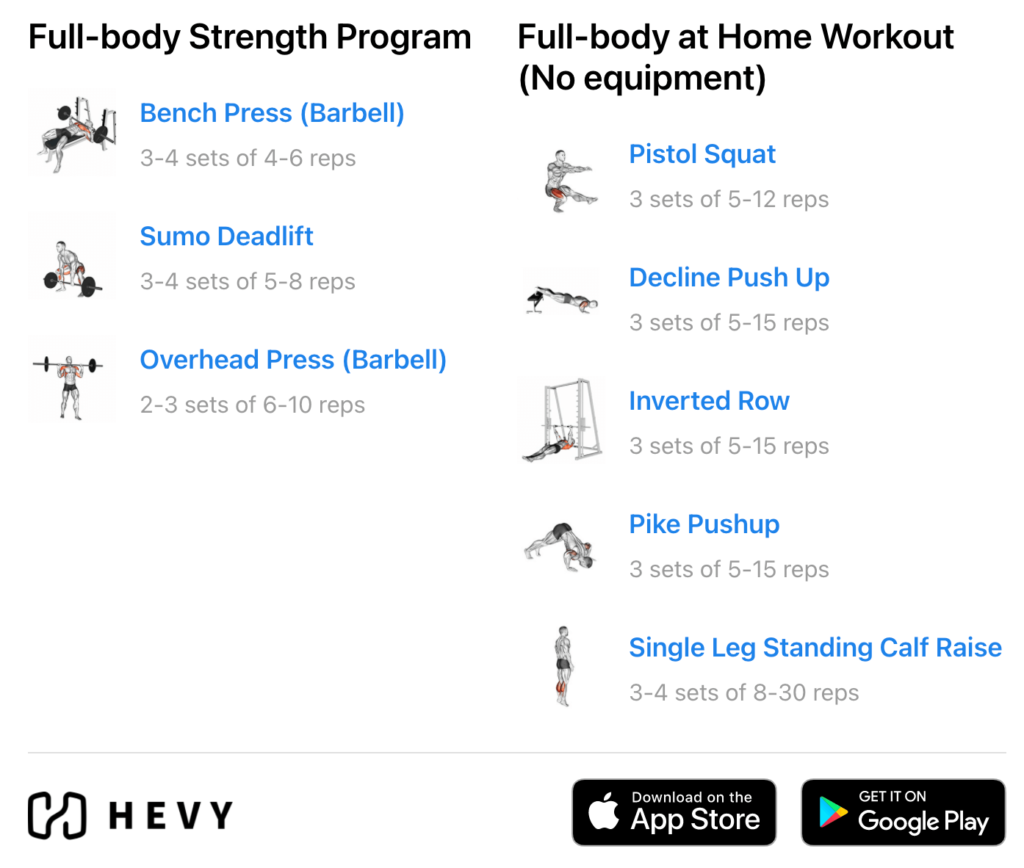

5. Full Body Dumbbell Workout
Dumbbell training is incredibly beneficial because:
- You can do most of the proven and effective exercises
- The overloading potential is fantastic
- You can get a pair of adjustable dumbbells and train at home
Besides that, dumbbells are fantastic because they allow us to train one side at a time and prevent side-to-side muscle imbalances from occurring. Plus, that also allows us to focus our efforts on a smaller body region, develop a good mind-muscle connection, and train with better technique.
Try other dumbbell workouts for the shoulders, chest, and legs.
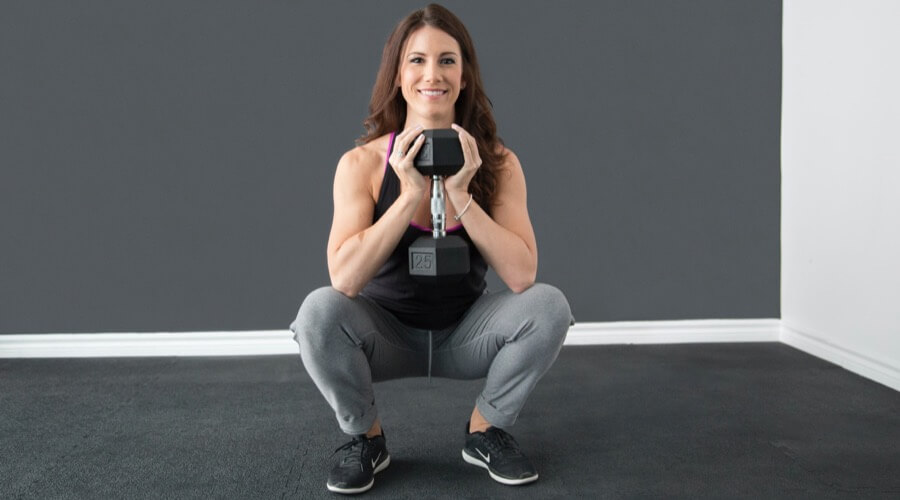
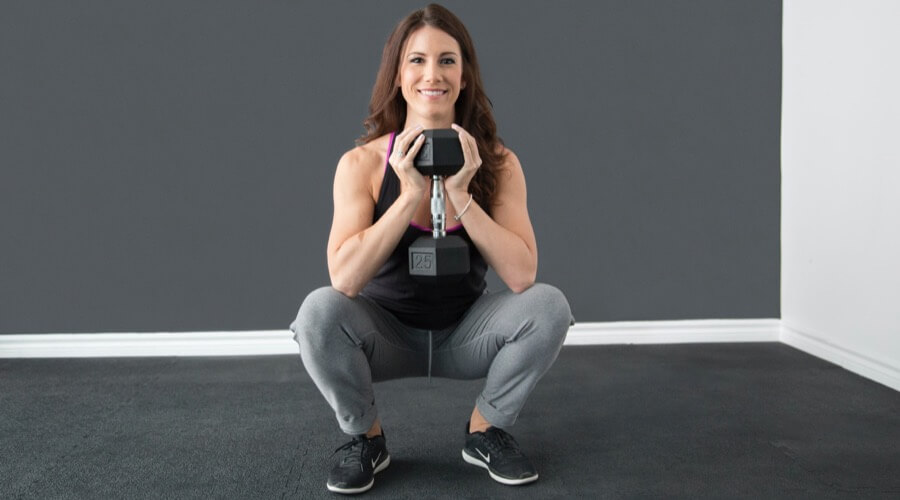
With that said, let’s go over a full-body dumbbell workout that trains all the major muscle groups in your body:
- Bent-Over Single-Arm Dumbbell Row – 3 sets of 8 to 12 reps
- Unilateral Dumbbell Floor Press – 3 sets of 8 to 12 reps
- Goblet Squats – 3 sets of 6 to 12 reps
- Overhead Dumbbell Press – 2-3 sets of 8 to 12 reps
- Romanian Dumbbell Deadlift – 2-3 sets of 10 to 12 reps
- Alternating Dumbbell Lunges – 2 sets of 10 to 15 reps (per leg)
- Standing Dumbbell Bicep Curls – 2 sets of 12 to 15 reps
- Overhead Dumbbell Tricep Extensions – 2 sets of 12 to 15 reps
- Bent-Over Reverse Fly – 2 sets of 15 to 25 reps


There are also the 5×5 programs which are great full-body workouts you can choose from, such as; Original 5×5, Madcow 5×5, or Stronglifts 5×5.
Three Profound Benefits Of Having a Strong Body
1.It Makes Your Everyday Life Easier
Few people realize the profound impact physical strength can have on our lives. No matter what your job is and how a typical day goes, you can always benefit from having a strong body. Whether you’re trying to carry bags full of groceries up a flight of stairs, do some manual labor, or pick your child up off the ground, you need physical strength.
The stronger we are, the more manageable everyday tasks become, and the more fulfilled we become. Though it may sound superficial, knowing that you’re physically capable is incredibly rewarding and allows you to do many things with ease.
Greater physical strength is also essential as we get older because it allows us to remain more independent, maintain good bone health, and avoid over-reliance on others for simple things (1, 8).
2. It Allows You to Contribute More, Leading to a more Fulfilled Life
One of the most significant benefits of weight training is the freedom it allows us to have. The freedom to do things, connect with people, contribute to something beyond ourselves, and explore the world around us.


It allows us to live our lives to the fullest, use our time more effectively, and feel good about ourselves. Imagine a future where you have that: the physical abilities to do things you now think are impossible and the impact that would have on your well-being and fulfillment.
How does it feel? Can you honestly say that the strength we gain in the gym is a vain characteristic with not much use in the real world? Or do you believe it has the power to shape your life for the better?
3. It Builds Your Self-Confidence and Self-Worth
“No man has the right to be an amateur in the matter of physical training. It is a shame for a person to grow old without seeing the beauty and strength of which his body is capable.” Socrates said that over 2,000 years ago, and he couldn’t be more accurate. Too many people never realize how amazing their body is, how capable it can become, and how deeply satisfying it is to work on our physical abilities.
More than anything, having a strong body makes you more confident and solidifies your sense of self-worth. Strength is more than being able to bench press 315 pounds or deadlift 500. It’s about proving to yourself that you’re capable of a lot more than you previously thought. It’s about building confidence and deep belief in yourself and your abilities.
Warming Up Correctly for Full Body Training
Too many trainees never take the time to warm up well, and that’s a huge mistake. Taking a few minutes to warm your body is vital for several important reasons. First, it prepares your body for the work you’re about to do (9). This warm-up includes your muscles, joints, and connective tissues. Second, it raises your core body temperature, which creates an optimal environment for work by warming up the enzymes responsible for energy production and improving your muscles’ elastic properties (9). Third, a good warm-up gets you in the mindset of working out. It gets you going, boosts your mood, and eases you into the workout.

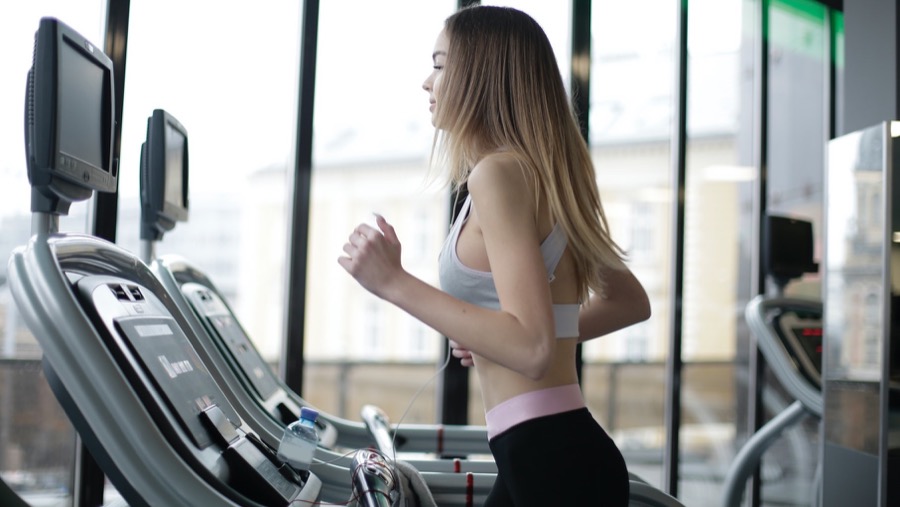
You don’t need to do that much to achieve these effects. For the most part, a general warm-up consisting of some light cardio and dynamic stretching will get you started. Then, you can do a few warm-up sets for your first exercise and jump into your workout. Let’s say that your first exercise of the day will be the barbell squat, and you plan on training with 225 pounds. Your warm-up sets can look like this:
The Big Five Lifts for Full Body Strength and Muscle Mass
1. Back Squats
The squat is among the most natural movement patterns we can do. The exercise primarily trains the lower body and involves upper body musculature, making for a fantastic activity that builds whole-body strength, balance, and muscular coordination (10).
Muscles trained: Quadriceps, Hamstrings, Glutes, Entire Back, Chest, Shoulders, and Arms
Equipment: Barbell, Weight Plates, and Squat Rack or Stand
- Set the barbell at collarbone height, extend your arms, and place your hands on top of it, slightly wider than shoulder level.
- Tuck under the bar and dig your upper traps into it. Take a breath, extend your knees, remove the bar from the rack, and take a couple of steps back.
- Plant the feet slightly wider than hips distance, point the toes slightly outwards, make sure your chest is out, and take another breath.
- Descend into a squat by bending at the knees and go down as comfortably as you can – ideally until your thighs are parallel with the floor.
- Push through your heels and go back to the top as you exhale.









Hevy – Workout Tracker
Create your own full-body workouts with Hevy, and track your progress









Hevy – Workout Tracker
Create your own full-body workouts with Hevy, and track your progress – for free.
2. Standing Barbell Shoulder Press
Set 1: 45 lbs (empty bar) for 8 to 10 reps
Set 2: 90 lbs for 3-5 reps
Set 3: 155 lbs for 1-2 reps
Set 4: 185 lbs for 1 rep
Set 5: 225 lbs (your first working set)
The shoulder press is primarily a deltoid exercise, but it also involves – and develops – your entire core, triceps, upper chest, and back.
Muscles trained: Shoulders (front and middle heads), Triceps, Upper Chest, Back, and Core
Equipment: Barbell, Weight Plates, and Barbell Stand
- Set the barbell at collarbone height, extend your arms, and grab it with an overhand grip and roughly at shoulder width.
- Tuck your body underneath the bar.
- Take a breath, and push through your knees to remove the bar from the rack.
- Take a step back, engage your glutes and abs, make sure your chest is out, and take another breath.
- Push through your triceps and press the bar in a straight vertical line until your elbows straighten.
- Carefully lower the bar to your upper chest as you exhale.
3. Pull-Ups
The pull-up is arguably one of the most effective bodyweight exercises for strengthening and developing your back, biceps, and core musculature. Back and bicep exercises are important for strengthening to help achieve a full pull-up.
Muscles trained: Upper and Lower Back, Biceps, Forearms, and Abs
Equipment: Pull-Up Bar
- Bring your arms into an extended position above your head with palms facing forward and grab the pull-up bar evenly and slightly wider than shoulder level.
- Bring your chest out, engage your core, squeeze your glutes, and take a breath.
- In one controlled motion, pull through your elbows and go up as high as you can – ideally, until your chin is at bar level.
- Lower your body slowly, allowing your elbows to extend almost entirely, and exhale near the bottom.
4. Flat Barbell Bench Press
The bench press is a prevalent exercise, and rightfully so. Thanks to its excellent overloading potential and a good range of motion, it strengthens and develops the chest, shoulders, and triceps.
Muscles trained: Chest, Shoulders (mainly the front head), Triceps, and Core
Equipment: Bench, Barbell, and Weight Plates
- Lay down on your back beneath the barbell with your forehead directly underneath the bar. Extend your arms and grab the bar firmly with a grip wider than your shoulders.
- Tuck your legs back and in as you dig your glutes into the bench. Simultaneously, bring your chest out and make sure your back is arched.
- Take a breath and push through your elbows to remove the bar from the rack. Carefully bring it over your chest.
- Take another breath and lower the bar to your chest while keeping your elbows tucked in; don’t flare them out. Lower the bar until gently tapping your chest, right around the nipple line, then press the bar straight up to the top, exhaling as you straighten your elbows.
- Once finished, carefully bring the bar back and rack it.
5. Deadlifts
Similar to the squat, deadlifts are a whole-body exercise with an incredible overloading potential. Regular training of deadlifts builds great strength, muscle mass, muscular coordination, and balance.
Muscles trained: Hamstrings, Glutes, Lower and Upper Back, Quadriceps, Abs, Shoulders, Arms, and Hands
Equipment: Barbell and Weight Plates
To do a conventional deadlift:
- Walk to the bar and have your shins a couple of inches away from it. When looking down, the bar should appear to split your feet in half.
- Bend forward slightly and grab the bar with an overhand grip at shoulder level.
- Without moving the bar, bring your chest out as you straighten your back. Shins come into contact with the bar and engage your entire body.
- Take a breath and initiate the pull by simultaneously digging your heels into the floor and extending your upper body through hip extension.
- Lift the barbell in a straight line and keep your back in a neutral position at all times.
- Once on top, begin to descend by keeping the same straight line, first break at the hips, then next at the knees.
- Exhale at the bottom and repeat.
How often should I do Full-Body Workouts?
We first need to know what appears to be optimal for muscle growth and strength gain.
First, research suggests that training volume (between 10 and 20 weekly sets per muscle group) is the most important thing for muscle growth, and frequency doesn’t seem to matter that much (3, 4). We must do enough work each week, and we can grow well.
But we also need to consider fatigue and the impact it has on our performance and growth. When we do too many sets in a single workout can lead to diminishing returns. Instead of causing more growth, we might get to a point where training further only piles fatigue and slows down recovery. Because of that, it makes more sense to split our weekly training into two or three sessions, which allows us to do our training in a fresher state and be more productive.
Second, research also shows that training frequency, independent of volume, is vital for strength gain (7). This statement makes sense because the more often we train a lift, the quicker we can become proficient, and the more we can develop our neuromuscular capacity. Research and experts recommend anywhere from two to three sessions per week (11).
So, how often should you do full-body workouts? Well, depending on your experience level and schedule, you should do anywhere from two to four weekly training. If you mostly care about strength gains, aim for three full-body workouts, always making sure to do some variation of the lifts you want to improve. If you are going to focus on hypertrophy, do anywhere from two to four workouts, depending on how experienced you are, how much work you can do each time you are at the gym, and how well you can recover between workouts.
Conclusion
Full body training is a tried and true method of organizing your weekly training. Many people prefer to use the popular approaches like the upper/lower, and push/pull/legs split; training your whole body offers its unique benefits.
Whatever your fitness level or training goals, you can take advantage of full-body workouts and achieve great results. For instance, you can program your training for optimal hypertrophy, strength, or some degree of the two goals. You can also put together excellent full-body home workouts without having any equipment. To help optimize workout tracking, use Hevy. Create workouts, track progress, and motivation to keep on track to achieve your goals.









Hevy – Workout Tracker
Create your own full-body workouts with Hevy, and track your progress









Hevy – Workout Tracker
Create your own full-body workouts with Hevy, and track your progress – for free.
As far as frequency goes, full-body training is quite flexible because we can make decent progress with as few as two weekly workouts. That alone makes full-body the obvious choice for everyone who can’t make it to the gym more frequently.
And lastly, full-body workouts are great for hypertrophy and strength training. They allow us to spread our weekly training volume more evenly and avoid doing too much work for any muscle group in any workout.
Frequently Asked Questions
What makes for an excellent full-body workout?
An excellent full-body workout lets you train all major muscle groups without needing too much work or leading to exhaustion. Keep a primary training goal in mind while adhering to all associated nuances surrounding training volume, intensity, and exercise selection.
Can I train my entire body at home?
Absolutely. You can do countless practical exercises to train all major muscle groups in your body, even if you don’t have any equipment. For reference, check out the workout I shared above.
How long should my workouts be?
An excellent full-body workout isn’t time-bound. Each training should take as long as it has to, allowing you to go down the list of exercises and recover enough between sets (6, 12).
How long should I rest between workouts?
Depending on your recoverability and how much work you do per workout. As a rule of thumb, give your body at least 48 hours to recover between workouts.



